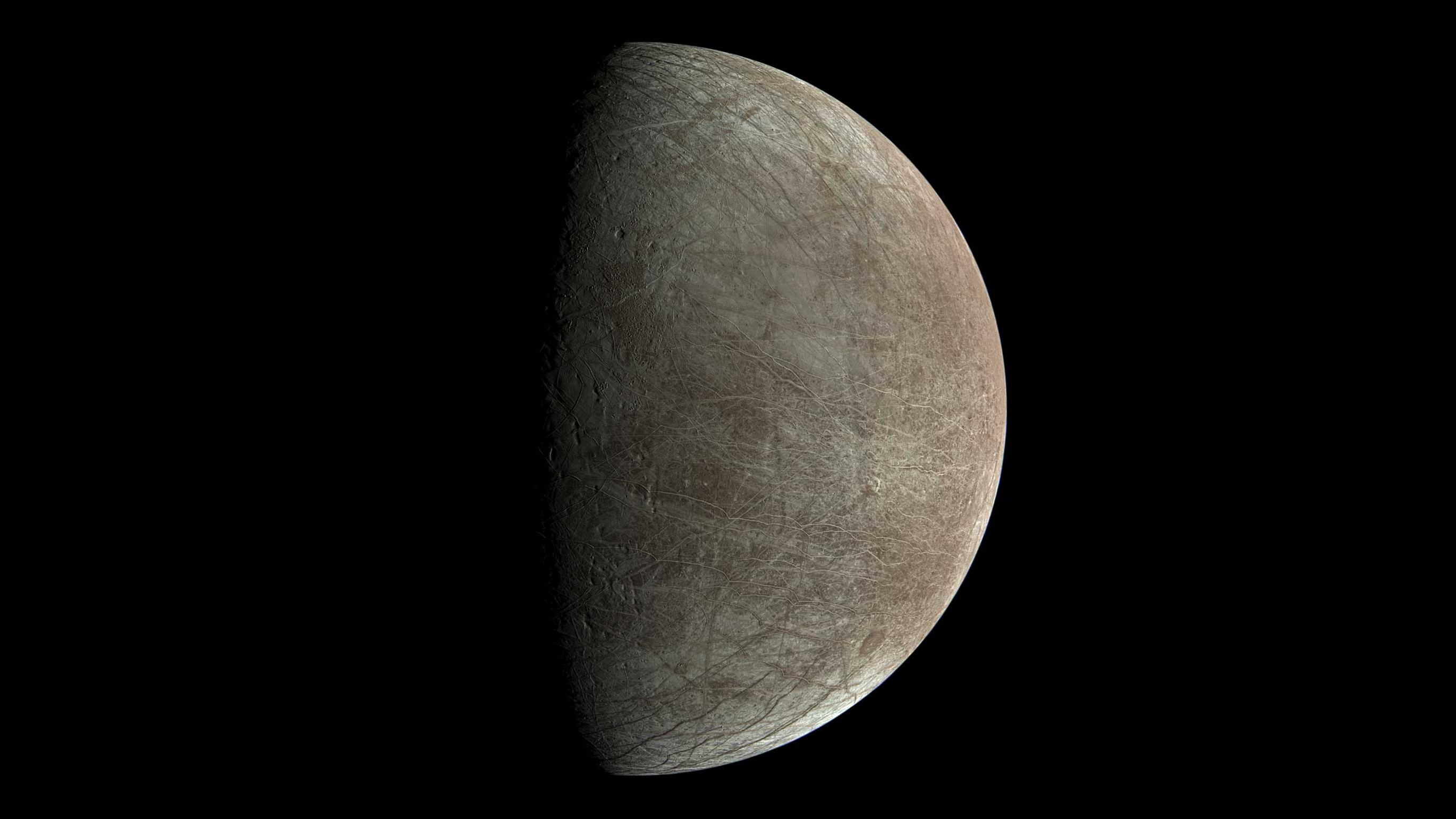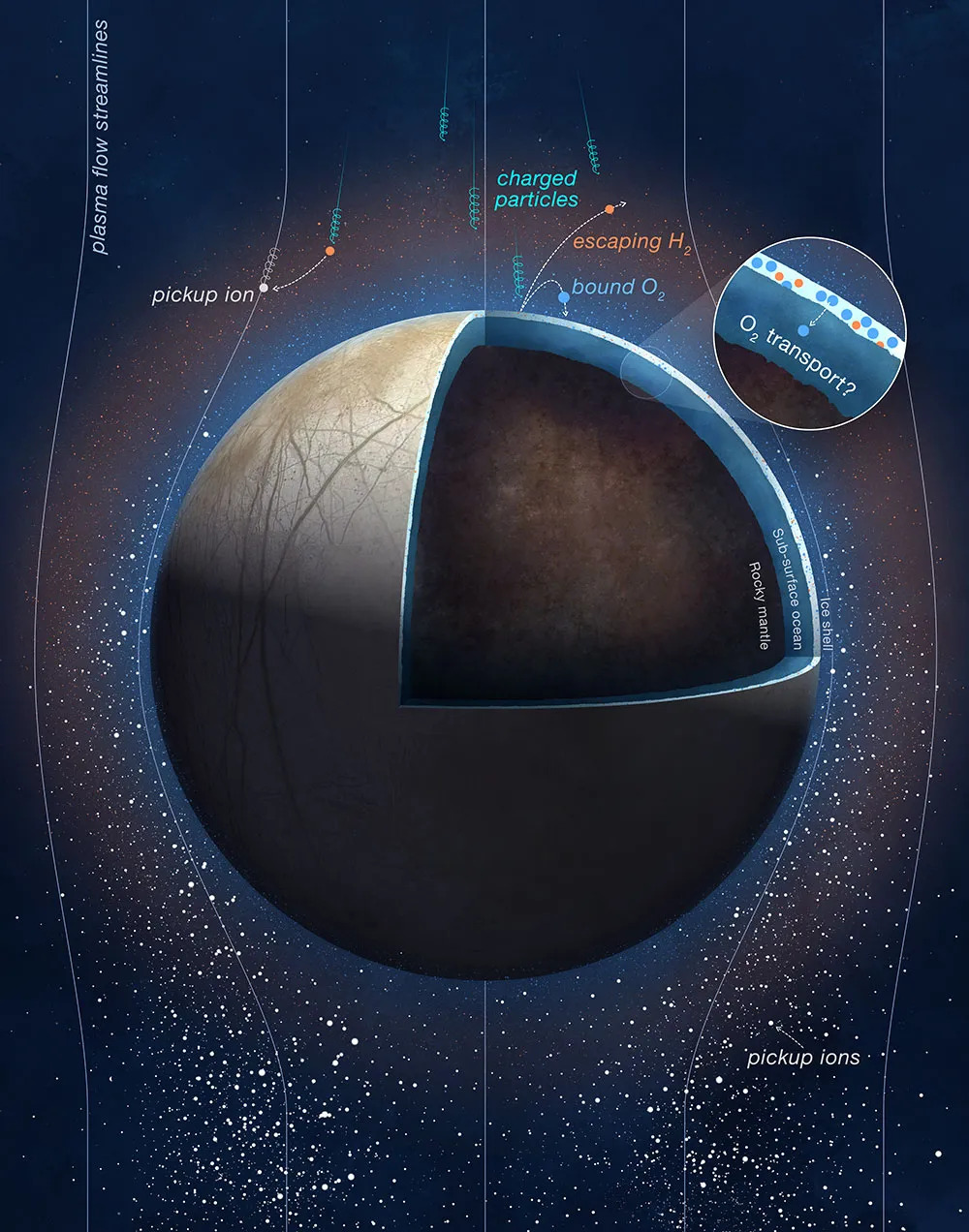
On Monday (March 4), scientists announced they've managed to measure how much molecular oxygen — the type of oxygen we breathe on Earth — likely exists around Jupiter's moon Europa. Although researchers have made estimates of the icy moon's oxygen content in the past, the team says this is the first time we've made a direct measurement of it.
To put it briefly, the result fell short of some quite high previous estimates. Could this mean Europa, believed to harbor a huge ocean of salty water beneath its icy shell, is less friendly than we'd hoped to the emergence of life? Or, at least, to life as we know it? Well, not necessarily, but the discussion is certainly an interesting one that invites further investigation.
Related: NASA Juno spacecraft picks up hints of activity on Jupiter's icy moon Europa
According to the study, some previous estimates of Europa's oxygen content were inferred from atomic oxygen emissions associated with the moon. Unlike molecular oxygen, which is made up of two oxygen atoms, atomic oxygen is made up of just one. The latter is the kind we cannot breathe, but scientists likely figured that decoding how much of it exists around Europa would place at least some constraints on how much breathable oxygen the moon produces overall.
That reasoning, in addition to a few other remote-observation analyses, indeed placed some limitations on how much of the stuff is truly associated with this Jovian satellite — but the new study found a way to get even narrower with these predictions. The researchers achieved a direct measurement of Europa's oxygen content thanks to NASA's Juno probe and a little bit of ice chemistry.
Basically, as the team explains in the study's abstract, it's possible Europa's water-ice shell of a surface has the potential to undergo a sort of water-splitting process. There are certain reactions that may turn some of Europa's frozen water molecules into molecular hydrogen (made of two hydrogen atoms) and molecular oxygen. And if such reactions truly happened, the proof would lie with some resulting oxygen and hydrogen ions around the moon — ions, as in they'd carry electrical charges. The theory had strong footing, as scientists knew Europa's orbital trajectory takes it through one of Jupiter's radiation belts. This belt has a bunch of charged particles that can impact the moon's surface, potentially triggering the water-splitting process.

Sure enough, in September of 2022, when Juno flew within 220 miles (354 kilometers) of Europa, it was able to identify proof of such water-splitting action, the team explains. The probe found hydrogen and oxygen ions that seemed to have been created by "bombarding charged particles," according to a NASA statement, that then got "picked up" by Jupiter's magnetic field as it swept past the moon.
"Here, we report direct observations of H2+ and O2+ pickup ions from the dissociation of Europa's water-ice surface and confirm these species are primary atmospheric constituents," the study reads.
As for some numbers, the scientists concluded the moon's atmosphere generates 26 pounds of molecular oxygen every second (12 kilograms per second.) Previous estimates, they say, range from a few pounds to over 2,000 pounds per second (about 900 kilograms per second.)
"Back when NASA's Galileo mission flew by Europa, it opened our eyes to the complex and dynamic interaction Europa has with its environment. Juno brought a new capability to directly measure the composition of charged particles shed from Europa's atmosphere, and we couldn't wait to further peek behind the curtain of this exciting water world," study lead author Jamey Szalay from Princeton University, one of Juno's instrument scientists, said in the statement. "But what we didn't realize is that Juno's observations would give us such a tight constraint on the amount of oxygen produced in Europa's icy surface."
Due to the value being lower than previously thought, the team writes in the study that this result introduces "a narrower range to support habitability in Europa's ocean." The worry stems in part from the fact that this water-production method may be the way Europa's subsurface oasis gets its oxygen.
But, as a statement provided by NASA points out, there's another way to think about this. "The ice-covered Jovian moon generates 1,000 tons of oxygen every 24 hours — enough to keep a million humans breathing for a day," it reads. Still, would life that lives on an exotic moon (even if it's life as we know it) have some exotic oxygen requirements? Stay tuned on that one.
As for what's next? The team says they're headed to dissect yet another Jovian moon: Io.
The study was published on March 4 in the journal Nature Astronomy.







